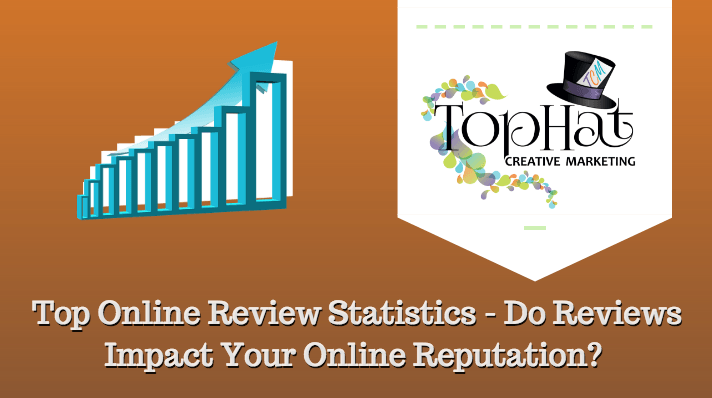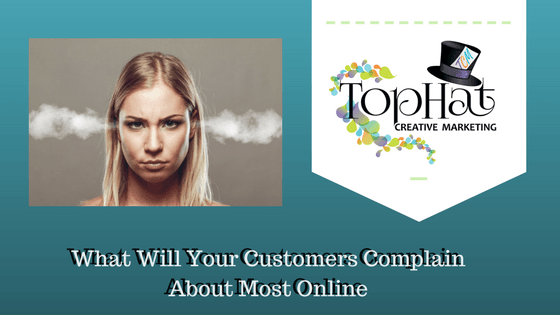Newsletter

Do reviews impact your online reputation? The short answer is: definitely. Online reviews build trust, help with search engine optimization (SEO), and contribute to your company’s digital portfolio. Since more than 88% of online shoppers use reviews before making shopping decisions and even Google searches of your company or product now include reviews and ratings, it’s obvious that reviews are something that can no longer be ignored. We’ve compiled statistics from multiple studies to help us navigate the world of online reviews. Here are our takeaways: According to BrightLocal (2016), 84% of people trust online reviews as much as a personal recommendation. Since word-of-mouth is still the most influential way to gain a customer, that’s a powerful statistic. It means that an online review holds the power of trust and credibility. How many reviews will it take for a solid opinion to form about a company or product? Ten, according to 90% of consumers. A star rating is now the number one factor used by consumers to judge a business. Don’t panic if you have a negative review, though. Consumers suspect censorship or faked reviews if they don’t see bad scores…95% of them, as a matter of fact. While having a negative review isn’t a destructive force on its own, ignoring them can be. Responding to negative reviews in a customer-service-friendly way can work wonders in gaining a new customer base. Invesp created a great infographic that lists several ways to manage negative reviews. We have a few suggestions based on our experience working in social media marketing. Most customers who leave negative reviews do so because of poor customer service. The words “rude” or “friendly” are common search words you may want to check out. Reliability, expertise, credibility, and professionalism are the most important factors they consider when making a purchase or selecting a service. Weber Shandwick’s case study showed some interesting information. As sponsored content and reviews are on the rise, consumers are putting more trust in consumer reviews (77%) over expert reviews (23%). If you’re a brick and mortar business, it’s essential that you keep your eye on independent review sites like Yelp, since a majority of those users will make a purchase based on those reviews. In this mobile culture, a consumer is 80% more likely to check Yelp or another review site before even stepping inside your store. When you consider that 98% of Yelp users make a purchase from a business they found on Yelp’s local search, you can see how important those reviews can be. Online reviews are critical to sales. Since 92% of consumers won’t do business with a company or select a product with less than a 4-star rating, you need to pay attention to what people are saying about you online. Do reviews impact your online reputation? The answer is yes. Can you do something about it? Definitely! If you’re not sure where to start, contact us for a free 30-minute audit of your online reputation.

Brand appeal is a term you should be familiar with. At its core, it encompasses the positive emotions associated with a brand. Think of brand appeal as the way you attract, stimulate, please, and trigger interest for potential clients and customers. The way you interact on social media has a direct impact on that impression. Your social media interaction should be an extension of your brand. Think about authors, businesses, and actors you may have followed on social media. Did you find their social media interaction completely at odds with the personality they portray through their brand? If so, did it detract from their image or enhance it some way? I’ve personally stopped following several brands because of their social media management. It also caused me to stop doing business with them altogether. Here are some social media pitfalls to avoid: Don’t push sales every post. It’s the 5-2-1 ratio. Share other’s messages and posts five times. This can include followers’ messages, kind words, or great memes, just make sure it aligns with your brand’s identity. Spend two posts offering help and tips in some way. It can be a video on how to operate an item you sell, or a printable checklist to prepare for tax season. Whatever you share needs to be generated by you to help seal brand trust in the minds of your customers and clients. The final post can be a sale post, but it needs to offer an incentive of some type. A discount, a free printable for signing up to a newsletter, but it needs to be worth their time. Remember, this is social media, not hard selling. You can mix and match your teaching posts with your shared content, but the sales post needs to always be at the end of your list. The only exception is when you have a last minute countdown post for a sale, event, etc. Decide whether or not you will publicly respond to customer complaints. You may not wish to get into a discussion right there about their problem, but you can offer up a response. Thank them for bringing the problem to your attention and offer a link to a feedback form so they can send the information directly to your customer complaint department. Facebook pages now allow you to interact with them on messenger. Important note here: you should respond in some fashion to complaints. Ignoring them completely will trigger a snowball effect that can lead to a reputation crisis. Don’t ignore brand mentions. Your customers and clients may not even follow your social media accounts. As a matter of fact, most people expect those accounts to be full of pushy ads. Emails, applications, and forums are the perfect places for people to talk about your brand. Since those are “dark social” places, analytics tools can’t be used here. Google alerts and manual searches are key to brand mention tracking. Don’t ignore messages! Prompt, informative, and sincere responses from brands can strengthen your brand reputation exponentially. Some social profiles will tell a person how long it takes to respond to messages. Social media should complement your branding and follow your vision. Spelling, grammar, and common sense are imperative to your reputation. Make sure your social media manager has your best interests in mind. To save time and effort, make sure you set up a response matrix for your social media accounts. There is a fantastic example in this SlideShare. A response matrix, also known as a social media reply protocol, shows your and your social media managers all response time requirements, answers, links to places you should offer in each type of comment or complaint, and more. Take your social media in hand and make sure you’re putting your best foot forward.

If you’ve been around for any length of time, you’ve seen your fair share of customer complaints. From online reviews for restaurants to product complaints on Facebook, customers are making their voices heard no matter the platform. Ignoring their complaints is detrimental to your success, so how do you prepare for it? The answer is easier than you think. Do your homework and create a response matrix. A response matrix is a list of instructions that inform you and your staff how to handle customer complaints in an effective manner. In order to create one, you’ll have to know what your customers will most likely complain about. According to a study conducted by Genesys Global Surveys, poor customer service is the biggest reason for lodging complaints. In the survey, the number one factor in poor customer service was how poorly they were treated. The second one was a failure to solve a problem in a timely manner. For every customer who complains, there are at least twenty-six who remain silent. Unhappy customers won’t return unless you give them a good reason to do so. Is your customer service streamlined for customers, or will they be jumping through hoops to reach a real person if there’s a complaint? Do you respond to complaints? If so, do you do it in a timely manner? We go more in depth on responding to negative reviews HERE. The way you respond to a customer complaint through your service center is imperative to the customer’s feelings about your company. A quality email response to a complaint is just as important as a timely one. Note that some surveys include employee behavior among poor customer service. For those that didn’t, rudeness and lack of interest in helping the customer were second only to poor customer service. The takeaway from this is that the way you treat your customers will directly affect your bottom line. Every customer wants to feel like they matter to your business. A poor customer service experience will spread twice as fast as a great experience. This is true in both word-of-mouth and online reviews. What complaints have you faced in your business? How did you work to solve them? Let us know in comments.

Live Video over social media gives you an instant visual connection with your customers and clients in a way never seen before. Facebook and YouTube prioritize live streams over pre-recorded/uploaded content. Most viewers will watch a live video through mobile devices, so you have an immediate reaction to your content. In addition, live videos are simple to set up and record. You can use your mobile device and nothing else if you like, though using an additional stabilization device (like a selfie stick or tripod) is preferable to prevent jarring from the viewer’s perspective. Here are some general tips for successful live videos: Prepare your live video set-up ahead of time Test your equipment Prepare a general walkthrough of how things will go. In live video, you never know what will happen, but being prepared is essential to success. Interact with your viewing public while you’re streaming. It may be easier to have others read the comments and hand them off to you to chat about. Great Live Video Ideas Unboxing Videos Unboxings are great ways to engage with your audience. An “unboxing” is a type of video where an individual opens a box, takes out the contents and completes any assembly required. Imagine receiving your spring product collection. Unboxing the contents can show the viewers the new items available in your store. If you have equipment or furniture that require installation, building an unboxing video that includes set up may be the way to go. Another idea is to “unbox” letters and mail items from customers and clients (with their permission, of course!). Tips: Make sure your unboxing goes as smoothly as possible. It’s okay to practice ahead of time on another box. You’re the subject matter expert on your own items. If viewers see you struggle with finding “panel A” and “slot B”, it won’t endear them to your product. Practice ahead of time. Safety instructions are important. Don’t discredit yourself by bypassing safety standards in installation, unboxing, etc. You represent your company, and that type of behavior reflects poorly on your company’s quality control. Q&A/FAQ Videos A Q&A/FAQ video is simple to accomplish. It can be a regular segment where you answer one question a week, or an in depth dive into a specific subject. Tips: Keep these short and to the point. You can either use questions you already have in place or ask questions during the live event. Have a list of questions with answers on standby for those dead spots where you get limited interaction. Tours Hosting a tour video is another great option. You can set up a tour of your work space, the factory, your shop, the calendar at your desk, and more. Tips: All confidential information must be covered and/or hidden. Your clients want to feel safe in your hands. The way you show yourself is the way you’ll be remembered. Neat and tidy are more than just a suggestion here. You’re representing your business. Keep the tour short. Walking through your entire building isn’t necessary (and can be nausea-inducing). Keep these short and sweet. These were just some ideas to get you started. What live videos have you enjoyed? Let us know in comments.

Word of mouth has always been king when it comes to gaining new customers and clients, but did you know that 84% of people trust online reviews as much as personal recommendations? Think about the last time you went to a new restaurant or bought something off of an online retailer like Amazon. Did you glance at the star rating before making your purchase? It takes less than 10 reviews for 90% of your consumers to form an opinion about a business. Why is that? Reviews build credibility in your business. This is something called social proof. Social proof is the foundation of consumer purchases. It’s a personal pressure to follow in the footsteps of other consumers and clients based on their recommendations. Basically, the more thought-provoking 5-star ratings and testimonials you have, the more other consumers and clients will be compelled to work with you. Social proof isn’t enough, however. Your customers and clients need to find you. Sites like Yelp, Healthgrades, Google Reviews, Zocdoc, and more provide connections to your business beyond a website and social media presence. It leverages the power of search engines to find your business and bring in those customers and clients you’re looking for. This is especially true if you have reviews on your site. As consumers have become more skilled at gathering information on businesses, your reviews become more important than ever. This is why it’s so important to ensure that your business information is up to date at Yelp, Google Maps, and more. We covered which sites you should target in this post. Remember, online reviews are necessary to gain traction in first page search results for your business in both keyword and local searches. The connection between online reviews and increased sales can’t be ignored. Reference link: BrightLocal 2016 Local Consumer Review Survey: https://www.brightlocal.com/learn/local-consumer-review-survey/

The health of any business is of chief importance. When we think of the health of our bodies, we talk in terms of “vitals”- our blood pressure, temperature, heart rate, etc. Measuring the health of a business is very similar; key indicators like liquidity, debt to assets ratios, and many others are quickly worked up and presented and meant to represent how well a business is doing. So, what are the specific vitals most often used to track the standing of a company? According to Forbes, the key performance indicators (KPI’s) that best represent the overall standing of a business, good or bad, are: Net Profit Before Tax (represents the profit per one dollar of sales) Current and Quick Ratios (represents the cash liquidity of the company) Accounts Payable Days and Accounts Receivable Days (Measures whether there is cash on hand to cover commitments) Inventory Days (outlines the number of days it takes to move inventory) However daunting the task of measuring and recording these indicators may seem, there is a wealth of knowledge out there on how to calculate these numbers and interpret them, which may be even more important. Generally, businesses who employ accountants or financial advisors will have these numbers presented to them quarterly. While financial indicators will continue to be highly regarded until the end of time, some other more culturally focused metrics have come to the forefront when discussing the health of a company. Various businesses find themselves looking at content as currency and page views, engagement, and social followings as vital KPI’s. Because customers have such easy access to the companies they buy goods or services from via social media, company websites, and forums- online presence has become as highly regarded form of well-being. A healthy company now encompasses much more than liquid assets- they have good reviews from those they’ve worked with, up-to-date google pages, optimized websites, and post content relevant to their target markets. It is safe to say that companies operating today are not able to rely solely on quantitative data when looking at their businesses under the scope of reality.

